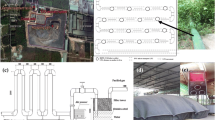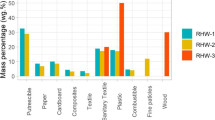Abstract
This study was conducted to evaluate the possibility of applying the stoichiometric methane potential using elemental analysis, to landfill gas modeling at the Sudokwon 2nd Landfill Site in South Korea, where most of the household and demolition waste from more than twenty million citizens is disposed. The used model structure is based on the first order decay equation. The theoretical stoichiometric methane potential was corrected by multiplying the ratio of decomposable carbon which was obtained by biochemical decomposable carbon test. Then the optimum reaction constant k was found by sensitivity analysis and the Monte Carlo method. Under these input conditions, the modeling results showed that the discrepancies between the measured and modeled values of total quantity of methane and the mean deviation were 1.6 and 3.2%, respectively. Thus, it can be established that the application of stoichiometric method using elemental analysis data could be a useful methods to apply to landfill gas modeling.




Similar content being viewed by others
References
Gewald D, Siokos K, Karellas S, Spliethoff H (2012) Waste heat recovery from a landfill gas-fired power plant. Renew Sustain Energy Rev 16(4):1781
Rasi S, Lantela J, Rintala J (2014) Upgrading landfill gas using a high pressure water absorption process. Fuel 115:539
Yang L, Ge X, Wan C, Yu F, Li Y (2014) Progress and perspectives in converting biogas to transportation fuels. Renew Sustain Energy Rev 40:1134
Yamada K, Ozaki Y, Nakagawa F, Tanaka M, Yoshida N (2003) An improved method for measurement of the hydrogen isotope ratio of atmospheric methane and its application to a Japanese urban atmosphere. Atmos Environ 37:1981
Sironi S, Capelli L, Ce´ntola P, Rosso RD, Grande MI (2005) Odour emission factors for assessment and prediction of Italian MSW landfills odour impact. Atmos Environ 39:5392
Mou Z, Scheutz C, Kjeldsen P (2014) Evaluating the biochemical methane potential (BMP) of low-organic waste at Danish landfills. Waste Manag 34(11):2254–2255
Faour AA, Reinhart DR, You H (2007) First-order kinetic gas generation model parameters for wet landfills. Waste Manag 27(7):948–953
Amini HR, Reinhart DR, Mackie KR (2012) Determination of first-order landfill gas modeling parameters and uncertainties. Waste Manag 32(2):311
Nagaoka A, Nose Y, Miyake H, Scarpulla MA, Yoshino K (2015) Solution growth of chalcopyrite compounds single crystal. Renew Energy 79:127–128
Fiore S, Ruffino B, Campo G, Roati C, Zanetti MC (2016) Scale-up evaluation of the anaerobic digestion of food-processing industrial wastes. Renew Energy 96:951–952
Themelis NJ, Ulloa PA (2007) Methane generation in landfills. Renew Energy 32(7):1247
Sialve B, Bernet N, Bernard O (2009) Anaerobic digestion of microalgae as a necessary step to make microalgal biodiesel sustainable. Biotechnol Adv 27(4):409–416
Browne JD, Murphy JD (2014) The impact of increasing organic loading in two phase digestion of food waste. Renew Energy 71:70
Bhattacharya SK, Uberoi V, Dronamraju MM (1996) Interaction between acetate fed sulfate reducers and methanogens. Water Resour 30(10):2240
Mata-Alvarez J, Dosta J, Romero-Güiza MS, Fonoll X, Peces M, Astals S (2014) A critical review on anaerobic co-digestion achievements between 2010 and 2013. Renew Sustain Energy Rev 36:146
Rincón B, Bujalance L, Fermoso FG, Martín A, Borja R (2013) Biochemical methane potential of two-phase olive mill solid waste: influence of thermal pretreatment on the process kinetics. Bioresour Technol 140:250
Pratt C, Walcroft AS, Deslippe J, Tate KR (2013) CH4/CO2 ratios indicate highly efficient methane oxidation by a pumice landfill cover-soil. Waste Manag 33(2):413
US EPA (1986) Measurement of gaseous emission rates from land surfaces using an emission isolation flux chamber user’s guide. 3–11. Report no EPA/600/8-86/008
Zhang H, He P, Shao L (2008) Methane emissions from MSW landfill with sandy soil covers under leachate recirculation and subsurface irrigation. Atmos Environ 42:5582–5587
Meima JA, Naranjo NM, Haarstrick A (2008) Sensitivity analysis and literature review of parameters controlling local biodegradation processes in municipal solid waste landfills. Waste Manag 28(5):906–911
Deng X, Zeng X, Vroman P, Koehl L (2010) Selection of relevant variables for industrial process modeling by combining experimental data sensitivity and human knowledge. Eng Appl Artif Intell 23(8):1370
Intergovernmental Panel on Climate Change (IPCC) (2006) 2006 IPCC guidelines for national greenhouse gas inventories Vol. 5, 3.13–14, 3.17
Tian BG, Si JT, Zhao Y, Wang HT, Hao JM (2007) Approach of technical decision-making by element flow analysis and Monte Carlo simulation of municipal solid waste stream. J. Environ Sci 19(5):636–637
López I, Passeggi M, Borzacconi L (2015) Validation of a simple kinetic modelling approach for agro-industrial waste anaerobic digesters. Chem Eng J 262:511–515
Cho DH, Shin SJ, Bae YW, Park CH, Ki YH (2011) Ethanol production from acid hydrolysates based on the construction and demolition wood waste using Pichia stipites. Bioresour Technol 102:4439
Muttil N, Ravichandra G, Bigger SW, Thorpe GR, Shailaja D, Singh SK (2014) Comparative study of bond strength of formaldehyde and soya based adhesive in wood fibre plywood. Proc Mater Sci 6:3
Acknowledgements
This study was supported by the Research Program funded by the Seoul National University of Science and Technology.
Author information
Authors and Affiliations
Corresponding author
Rights and permissions
About this article
Cite this article
Chun, SK. Application of the stoichiometric methane potential obtained by waste elemental analysis to landfill gas modeling. J Mater Cycles Waste Manag 20, 738–744 (2018). https://doi.org/10.1007/s10163-017-0633-1
Received:
Accepted:
Published:
Issue Date:
DOI: https://doi.org/10.1007/s10163-017-0633-1




